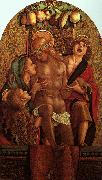
Oil On
Canvas, Real Flavor of Old Masters
|
Carlo Crivelli
|
|||
|
|
|||
| 1430-1495 Italian Carlo Crivelli Locations 1495). He produced many large, multi-partite altarpieces in which his highly charged, emotional use of line, delight in detail, decoration and citric colours, often set against a gold ground, convey an intensity of expression unequalled elsewhere in Italy. His mastery of perspective was also used for dramatic impact. As he worked in isolation in the Marches, his style only had local influence. In the 19th century, however, he was one of the most collected of 15th-century Italian painters. | |||
|
|
|||
|
|
Lamentation over the Dead Christ Carlo Crivelli2.jpg Painting ID:: 670 Visit European Gallery |
1485 Museum of Fine Arts, Boston | |
Height Width |
INS/CM |
||
|
X |
|
||
|
|
|||
|
GIOTTO di Bondone
|
|||
|
|
|||
| Italian Early Renaissance Painter, 1267-1337 Italian painter and designer. In his own time and place he had an unrivalled reputation as the best painter and as an innovator, superior to all his predecessors, and he became the first post-Classical artist whose fame extended beyond his lifetime and native city. This was partly the consequence of the rich literary culture of two of the cities where he worked, Padua and Florence. Writing on art in Florence was pioneered by gifted authors and, although not quite art criticism, it involved the comparison of local artists in terms of quality. The most famous single appreciation is found in Dante's verses (Purgatory x) of 1315 or earlier. Exemplifying the transience of fame, first with poets and manuscript illuminators, Dante then remarked that the fame of Cimabue, who had supposed himself to be the leader in painting, had now been displaced by Giotto. Ironically, this text was one factor that forestalled the similar eclipse of Giotto's fame, which was clearly implied by the poet. | |||
|
|
|||
|
|
Lamentation over the Dead Christ new4/GIOTTO di Bondone-973359.jpg Painting ID:: 30389 Visit European Gallery |
mk68 Fresco Padua Arena Chapel c.1306 Italy | |
Height Width |
INS/CM |
||
|
X |
|
||
|
|
|||
|
GIOTTO di Bondone
|
|||
|
|
|||
| Italian Early Renaissance Painter, 1267-1337 Italian painter and designer. In his own time and place he had an unrivalled reputation as the best painter and as an innovator, superior to all his predecessors, and he became the first post-Classical artist whose fame extended beyond his lifetime and native city. This was partly the consequence of the rich literary culture of two of the cities where he worked, Padua and Florence. Writing on art in Florence was pioneered by gifted authors and, although not quite art criticism, it involved the comparison of local artists in terms of quality. The most famous single appreciation is found in Dante's verses (Purgatory x) of 1315 or earlier. Exemplifying the transience of fame, first with poets and manuscript illuminators, Dante then remarked that the fame of Cimabue, who had supposed himself to be the leader in painting, had now been displaced by Giotto. Ironically, this text was one factor that forestalled the similar eclipse of Giotto's fame, which was clearly implied by the poet. | |||
|
|
|||
|
|
Lamentation over the Dead CHrist new4/GIOTTO di Bondone-465844.jpg Painting ID:: 30947 Visit European Gallery |
mk68 c.1306 | |
Height Width |
INS/CM |
||
|
X |
|
||
|
|
|||
|
Domenicho Ghirlandaio
|
|||
|
|
|||
| Renaissance Artists , 1449-94 | |||
|
|
|||
|
|
Lamentation over the Dead Christ new4/Domenicho Ghirlandaio-865484.jpg Painting ID:: 32338 Visit European Gallery |
c. 1472 Fresco | |
Height Width |
INS/CM |
||
|
X |
|
||
|
|
|||










